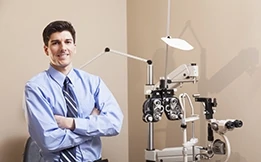What if LASIK doesn’t work? Find out the Facts!

When you choose a laser vision correction procedure, you go into it with an expectation of better vision that frees you from needing glasses or contacts. The day of the procedure, you expect to see better immediately, but you know there is a recovery process after LASIK and during that time you should expect to see gradual improvement. And, for the vast majority of people who choose LASIK, this is their experience. Many patients see better after LASIK without glasses or contacts than they did with their best prescription prior to surgery.
How Often Does LASIK Not Work?
Typically less than 5 percent of the time, LASIK doesn’t meet the patient’s expectations for vision improvement. For those patients, even after healing, there may be some residual nearsightedness, farsightedness, or astigmatism. This means some, but not all, of the visual problem was corrected by LASIK. This is more common in patients with high prescriptions. Although nearly 100 percent of LASIK patients achieve better than 20/40 vision, because each person is different, how a person heals can impact the final visual outcome of the procedure. Often, a LASIK enhancement procedure can be performed to fine-tune the prescription. This is indicated less than 5% of the time. In very rare cases, glasses and/or contacts may be needed to see well some or all of the time.
Which isn’t the result you expected when you chose laser vision correction for your vision needs – so it is natural to be disappointed.
LASIK Expectations
As mentioned above LASIK is extremely effective and in nearly every case is able to improve a patient’s vision. It is still important to know going into the procedure that the possibility you won’t be completely free of glasses – exists, even if the chance is small. And, it is important to note, that having laser vision correction doesn’t prevent you from needing glasses at some time in the future due to age-related vision conditions such as presbyopia (the need for reading glasses which happens to all of us at some point) and cataracts.
Just as important is to continue to work with your eye doctor during and after your healing and keep him or her informed about:
- Your overall experience with your vision correction after LASIK
- Any symptoms you may be having, such as dry eyes, night vision issues, or light sensitivity
What if LASIK Doesn’t Work?
After laser vision correction it is important to keep all of your post-op appointments and follow the recommended treatments. During those visits, you should talk with your ophthalmologist about your concerns during the healing process – which may last up to a year. Once your healing is complete and your eyes and vision are stabilized, you and your ophthalmologist can continue mapping out a plan for achieving your healthy vision goals. Today’s advanced vision correction technologies offer many options, including dry eye treatments and, potentially, a second laser vision correction procedure – also known as a retreatment or enhancement. Most of the time the second treatment is performed 3 months or more following your original LASIK and is done at no cost to the patient, but this should be determined prior to the initial surgery. You may also be comfortable wearing glasses only for certain activities, such as driving at night or reading.
Because vision goals are different for each person, many find that there is a lot of benefits to simply reducing – rather than eliminating – their need for glasses or contacts. For others, it is important to continue to work toward being free from corrective lenses altogether, if possible.
Your ophthalmologist is the best resource for learning about your options, the risks, and benefits of LASIK, and what to expect moving forward.




